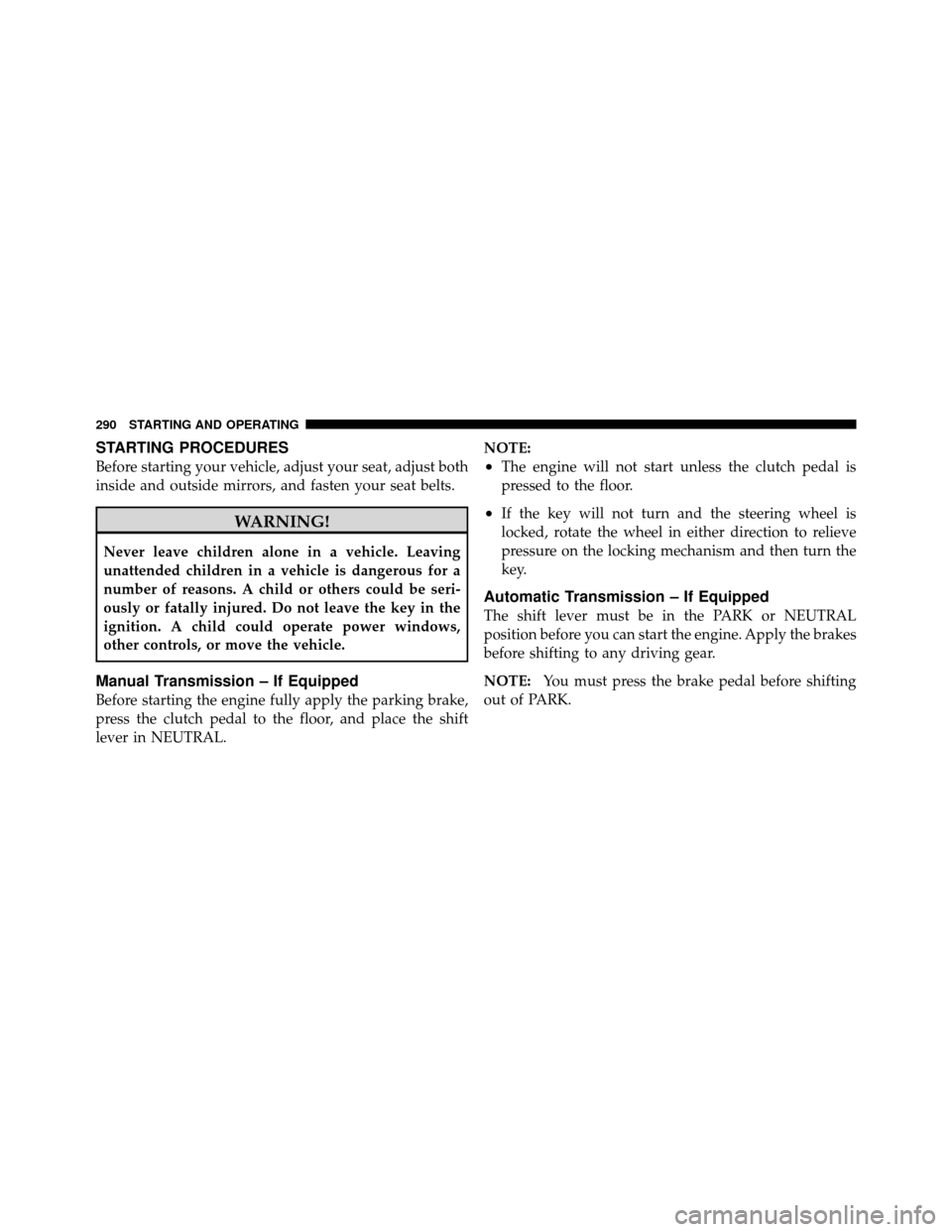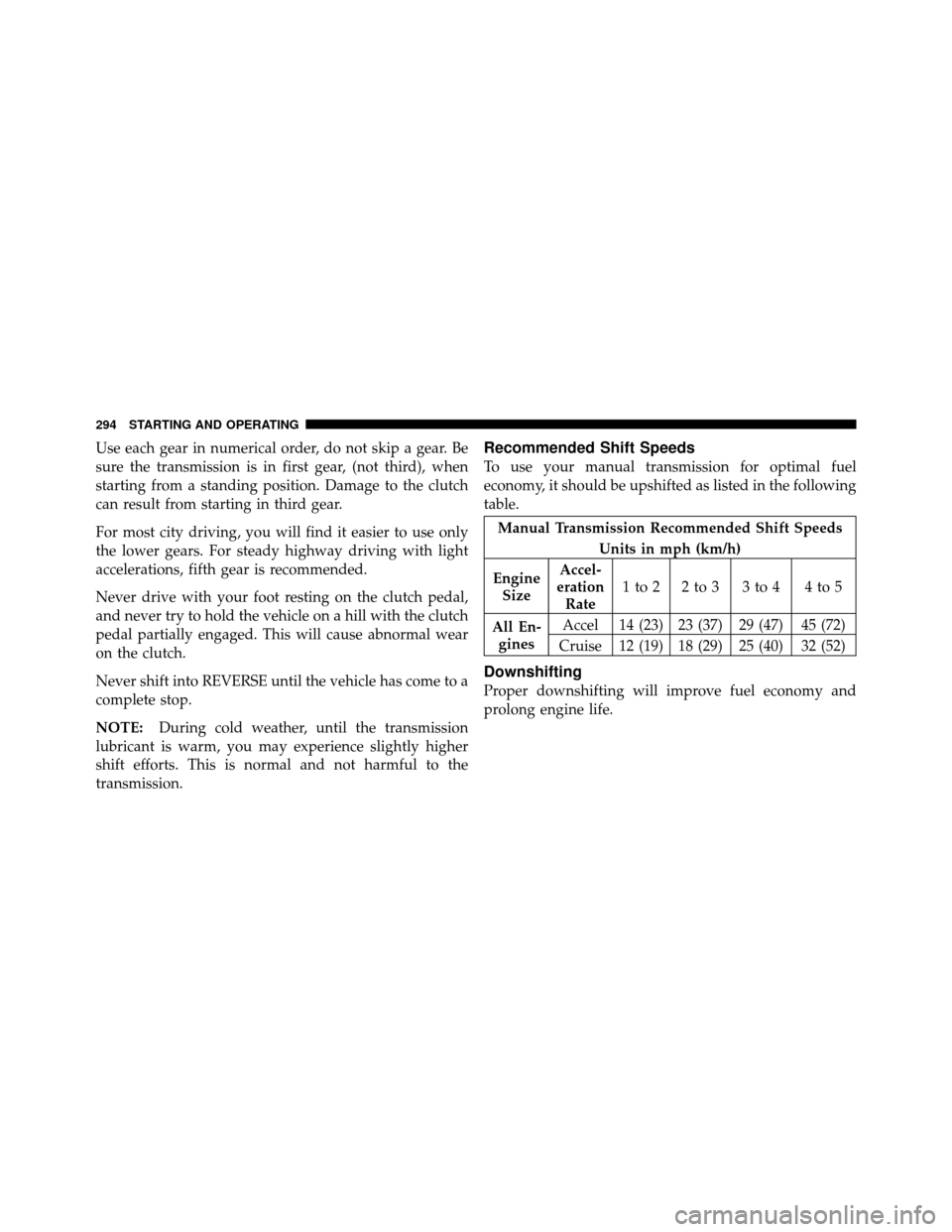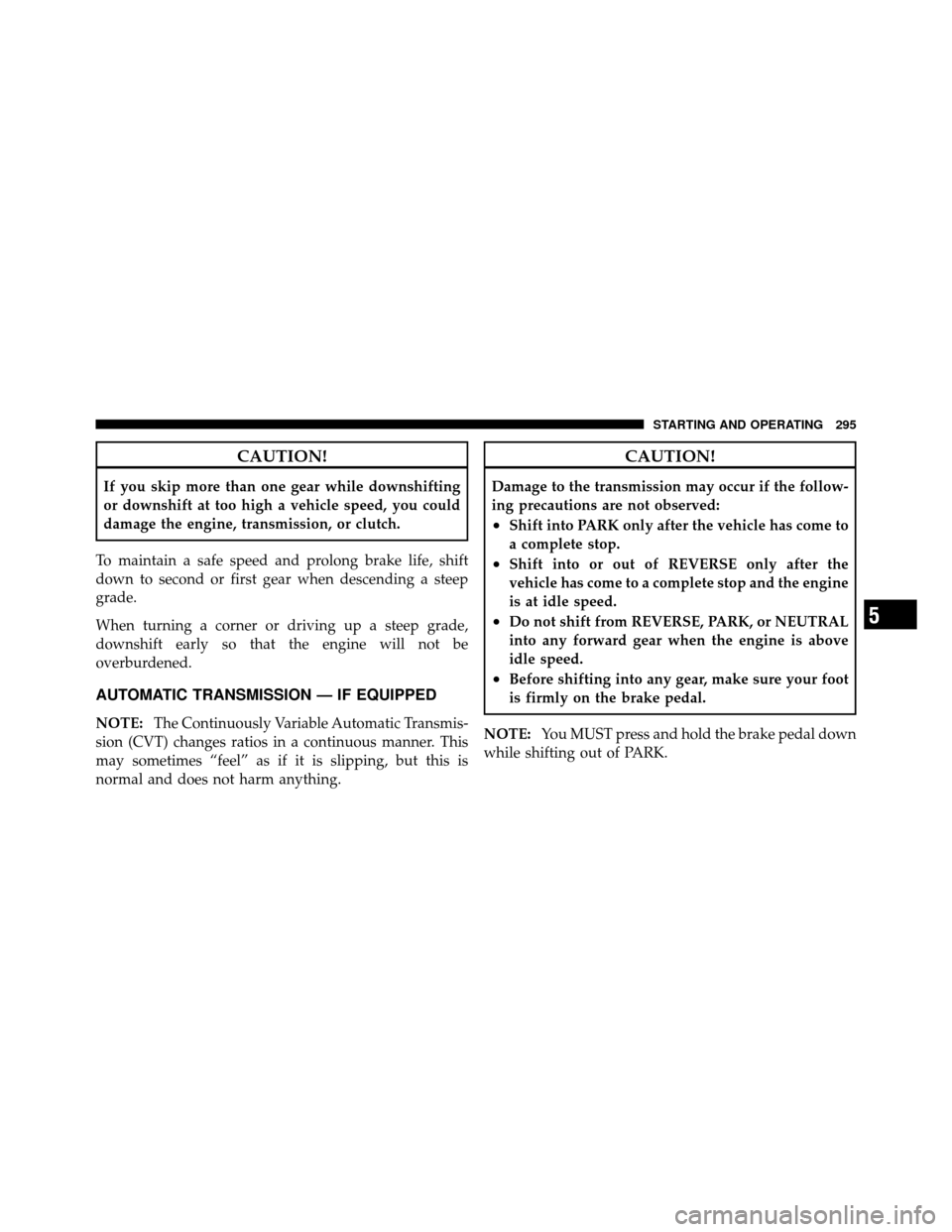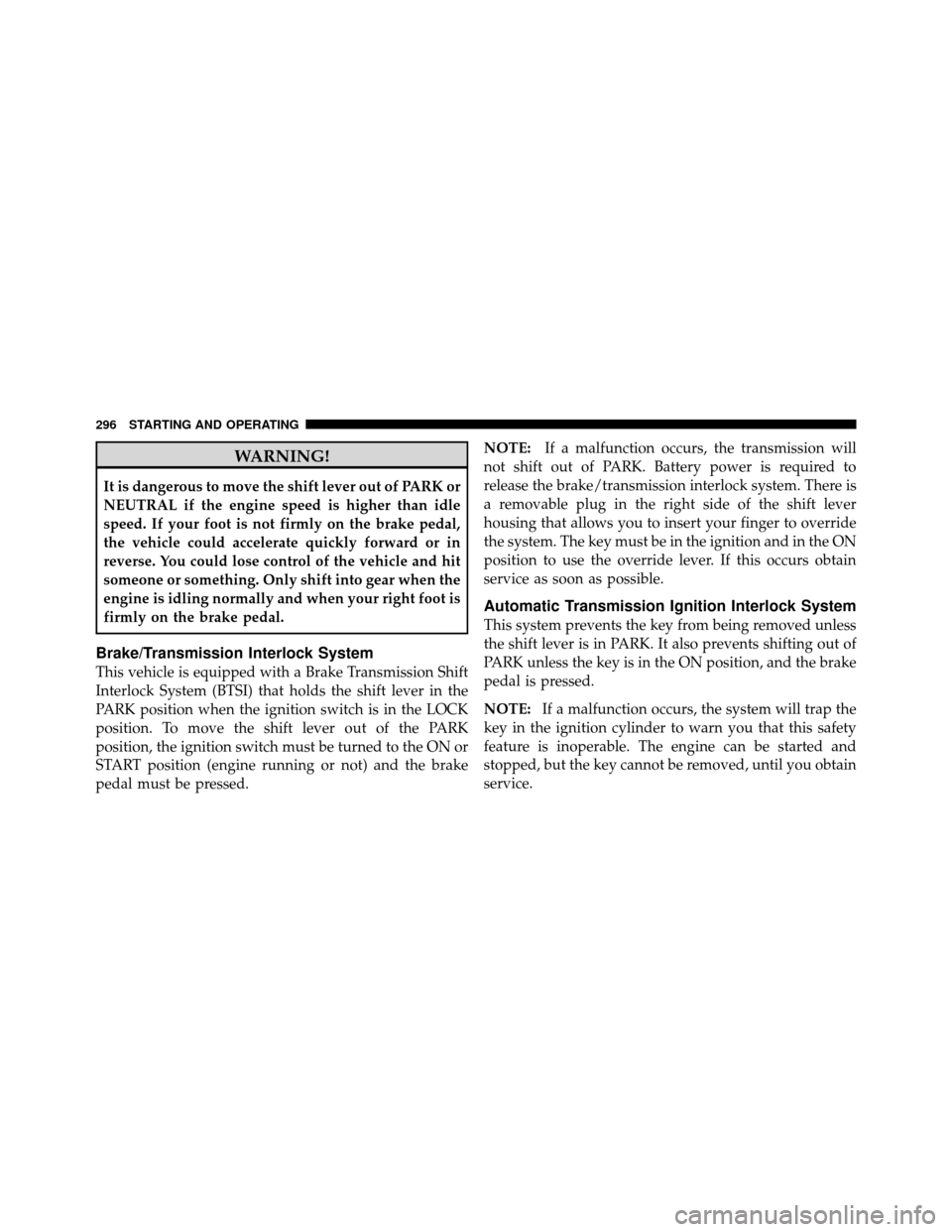Page 286 of 496
STARTING AND OPERATING
CONTENTS
�Starting Procedures .................... 290
▫ Manual Transmission – If Equipped ....... 290
▫ Automatic Transmission – If Equipped ..... 290
▫ Normal Starting ..................... 291
▫ Extreme Cold Weather
(Below �20°F Or �29°C)............... 291
▫ If Engine Fails To Start ................ 292
▫ After Starting ....................... 292
� Engine Block Heater — If Equipped ........ 292�
Manual Transmission — If Equipped ........ 293
▫ Five–Speed Manual Transmission ......... 293
▫ Recommended Shift Speeds ............. 294
▫ Downshifting ....................... 294
� Automatic Transmission — If Equipped ...... 295
▫ Brake/Transmission Interlock System ...... 296
▫ Automatic Transmission Ignition Interlock
System ............................ 296
▫ Gear Ranges ........................ 297
5
Page 288 of 496

▫Brake Assist System (BAS) .............. 322
▫ Traction Control System (TCS) ........... 323
▫ Electronic Roll Mitigation (ERM) ......... 323
▫ Hill Descent Control (HDC) – If Equipped . . 324
▫ Hill Start Assist (HSA) – Manual
Transmission Or Off-Road Package Only .... 326
▫ Electronic Stability Control (ESC) ......... 327
� Tire Safety Information ................. 332
▫ Tire Markings ....................... 332
▫ Tire Identification Number (TIN) ......... 336
▫ Tire Terminology And Definitions ......... 337
▫ Tire Loading And Tire Pressure .......... 338
� Tires — General Information ............. 342▫
Tire Pressure ....................... 342
▫ Tire Inflation Pressures ................ 343
▫ Tire Pressures For High Speed Operation . . . 345
▫ Radial Ply Tires ..................... 345
▫ Compact Spare Tire – If Equipped ........ 345
▫ Tire Spinning ....................... 346
▫ Tread Wear Indicators ................. 347
▫ Life Of Tire ........................ 348
▫ Replacement Tires .................... 348
� Tire Chains .......................... 349
� Snow Tires .......................... 350
� Tire Rotation Recommendations ........... 350
5
STARTING AND OPERATING 287
Page 291 of 496

STARTING PROCEDURES
Before starting your vehicle, adjust your seat, adjust both
inside and outside mirrors, and fasten your seat belts.
WARNING!
Never leave children alone in a vehicle. Leaving
unattended children in a vehicle is dangerous for a
number of reasons. A child or others could be seri-
ously or fatally injured. Do not leave the key in the
ignition. A child could operate power windows,
other controls, or move the vehicle.
Manual Transmission – If Equipped
Before starting the engine fully apply the parking brake,
press the clutch pedal to the floor, and place the shift
lever in NEUTRAL.NOTE:
•The engine will not start unless the clutch pedal is
pressed to the floor.
•If the key will not turn and the steering wheel is
locked, rotate the wheel in either direction to relieve
pressure on the locking mechanism and then turn the
key.
Automatic Transmission – If Equipped
The shift lever must be in the PARK or NEUTRAL
position before you can start the engine. Apply the brakes
before shifting to any driving gear.
NOTE:
You must press the brake pedal before shifting
out of PARK.
290 STARTING AND OPERATING
Page 294 of 496
WARNING!
Remember to disconnect the cord before driving.
Damage to the 110-115 Volt electrical cord could cause
electrocution.
MANUAL TRANSMISSION — IF EQUIPPED
Five–Speed Manual Transmission
WARNING!
You or others could be injured if you leave the
vehicle unattended without having the parking
brake fully applied. The parking brake should al-
ways be applied when the driver is not in the vehicle,
especially on an incline.Fully press the clutch pedal before you shift gears. As you
release the clutch pedal, lightly press the accelerator
pedal.
Shift Pattern
5
STARTING AND OPERATING 293
Page 295 of 496

Use each gear in numerical order, do not skip a gear. Be
sure the transmission is in first gear, (not third), when
starting from a standing position. Damage to the clutch
can result from starting in third gear.
For most city driving, you will find it easier to use only
the lower gears. For steady highway driving with light
accelerations, fifth gear is recommended.
Never drive with your foot resting on the clutch pedal,
and never try to hold the vehicle on a hill with the clutch
pedal partially engaged. This will cause abnormal wear
on the clutch.
Never shift into REVERSE until the vehicle has come to a
complete stop.
NOTE:During cold weather, until the transmission
lubricant is warm, you may experience slightly higher
shift efforts. This is normal and not harmful to the
transmission.Recommended Shift Speeds
To use your manual transmission for optimal fuel
economy, it should be upshifted as listed in the following
table.
Manual Transmission Recommended Shift Speeds
Units in mph (km/h)
Engine Size Accel-
eration Rate 1to2 2to3 3to4 4to5
All En- gines Accel 14 (23) 23 (37) 29 (47) 45 (72)
Cruise 12 (19) 18 (29) 25 (40) 32 (52)
Downshifting
Proper downshifting will improve fuel economy and
prolong engine life.
294 STARTING AND OPERATING
Page 296 of 496

CAUTION!
If you skip more than one gear while downshifting
or downshift at too high a vehicle speed, you could
damage the engine, transmission, or clutch.
To maintain a safe speed and prolong brake life, shift
down to second or first gear when descending a steep
grade.
When turning a corner or driving up a steep grade,
downshift early so that the engine will not be
overburdened.
AUTOMATIC TRANSMISSION — IF EQUIPPED
NOTE: The Continuously Variable Automatic Transmis-
sion (CVT) changes ratios in a continuous manner. This
may sometimes “feel” as if it is slipping, but this is
normal and does not harm anything.
CAUTION!
Damage to the transmission may occur if the follow-
ing precautions are not observed:
•Shift into PARK only after the vehicle has come to
a complete stop.
•Shift into or out of REVERSE only after the
vehicle has come to a complete stop and the engine
is at idle speed.
•Do not shift from REVERSE, PARK, or NEUTRAL
into any forward gear when the engine is above
idle speed.
•Before shifting into any gear, make sure your foot
is firmly on the brake pedal.
NOTE: You MUST press and hold the brake pedal down
while shifting out of PARK.
5
STARTING AND OPERATING 295
Page 297 of 496

WARNING!
It is dangerous to move the shift lever out of PARK or
NEUTRAL if the engine speed is higher than idle
speed. If your foot is not firmly on the brake pedal,
the vehicle could accelerate quickly forward or in
reverse. You could lose control of the vehicle and hit
someone or something. Only shift into gear when the
engine is idling normally and when your right foot is
firmly on the brake pedal.
Brake/Transmission Interlock System
This vehicle is equipped with a Brake Transmission Shift
Interlock System (BTSI) that holds the shift lever in the
PARK position when the ignition switch is in the LOCK
position. To move the shift lever out of the PARK
position, the ignition switch must be turned to the ON or
START position (engine running or not) and the brake
pedal must be pressed.NOTE:
If a malfunction occurs, the transmission will
not shift out of PARK. Battery power is required to
release the brake/transmission interlock system. There is
a removable plug in the right side of the shift lever
housing that allows you to insert your finger to override
the system. The key must be in the ignition and in the ON
position to use the override lever. If this occurs obtain
service as soon as possible.
Automatic Transmission Ignition Interlock System
This system prevents the key from being removed unless
the shift lever is in PARK. It also prevents shifting out of
PARK unless the key is in the ON position, and the brake
pedal is pressed.
NOTE: If a malfunction occurs, the system will trap the
key in the ignition cylinder to warn you that this safety
feature is inoperable. The engine can be started and
stopped, but the key cannot be removed, until you obtain
service.
296 STARTING AND OPERATING
Page 298 of 496
Gear Ranges
DO NOT race the engine when shifting from PARK or
NEUTRAL positions into another gear range.
PARK
This range supplements the parking brake by locking the
transmission. The engine can be started in this range.
Never use PARK while the vehicle is in motion. Apply
the parking brake when leaving the vehicle in this range.
Always apply the parking brake first, and then place the
shift lever in the PARK position.
WARNING!
•Unintended movement of a vehicle could injure
those in and near the vehicle. As with all vehicles,
you should never exit a vehicle while the engine is
running. Before exiting a vehicle, you should
always shift the vehicle into PARK, remove the
key from the ignition, and apply the parking
brake. Once the key is removed from the ignition,
the shift lever is locked in the PARK position,
securing the vehicle against unwanted movement.
Furthermore, you should never leave unattended
children inside a vehicle.(Continued)
5
STARTING AND OPERATING 297